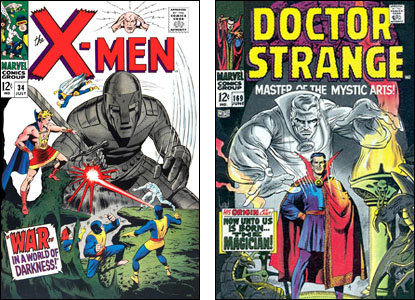
J. David Spurlock, who runs the Wallace Wood Estate, has announced the death of comic artist Dan Adkins last week. Adkins was 76, having been born in Midkiff, West Virginia in 1937. He was a draftsman in the Air Force and later a commercial artist — but one with a long interest in comic books, especially the EC Comics of the early fifties. In the late fifties, he became active in science-fiction fandom, contributing drawings to various fanzines and publishing one of his own called Sata. His illustrations also turned up in s-f pulp magazines of the early sixties like Galaxy and Amazing Stories.
In 1964, he began working as an assistant to Wally Wood. As an artist, Adkins was something of a chameleon who picked up the drawing styles of other artists. That made him an ideal employee for Wood with whom he worked on dozens of projects, most notably the early issues of T.H.U.N.D.E.R. Agents. Sometimes, Wood pencilled and Adkins inked. Sometimes, it was the other way around. But most often, they both did both on the pages and Adkins wrote a few scripts, as well. He assisted Wood on several jobs for Creepy and Eerie and then began drawing stories on his own for those publications.
In 1967, Adkins began working for Marvel, at first pencilling and inking his own work with occasional stories for X-Men, Doctor Strange, the Sub-Mariner series in Tales to Astonish and other features. The work was nicely rendered but readers began to notice a sensation of déjà vu about it. Much of it was created by tracing the work of other artists — not an unprecedented tactic in comics but rarely quite this obvious and often. Something of a controversy erupted in fandom over the morality of Adkins signing his name to drawing that were so much the work of other artists and Adkins wrote to several fanzines to defend himself. "Swiping" was, he noted, a time-honored tradition in comics.
That was so but a few of the artists from whom he swiped complained and Marvel lawyers began to worry about possible legal action from other publishers. The firm had threatened action against others who'd lifted designs from the pages of their books and feared that if nothing else, Adkins' swiping would undermine any claims they might make in that area. Editor Stan Lee was also uncomfortable with Adkins' storytelling. The pages looked great but, he felt, Adkins had a tendency to draw the image he had available for copying rather than the image called for by the storyline. By mutual agreement, Adkins cut back on his pencilling and did more inking of other artists' work. Paired with the right guy — say, Gil Kane or John Buscema — the end product could be quite impressive.
In the seventies, he was an Art Director for Marvel, focusing most of his attention on their line of black-and-white magazines. Before and after that job, he ran a little studio arrangement from his home, employing other artists to assist him with his comic book work for Marvel and several other publishers. Most of his aides were young "discoveries" of his and so he gave early assignments to several who went on to impressive careers in comics, including Val Mayerik and Don Newton. He drifted away from the business in the eighties, occasionally doing commission work for his many fans. He had a lot of them.
I only met Dan Adkins a few times — not nearly enough to say I knew him. Those who did spoke well of him as a person and as a hard-working artist who cared about his craft. We note and mourn his passing.